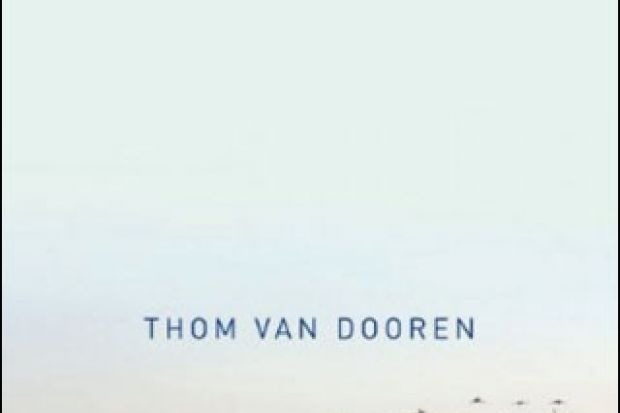Imagine wanting to save a species so badly that you spend every spring courting a confused crane with your best imitations of crane dancing, singing and nest building so that she will be receptive to artificial insemination: some conservationists do just that. The whooping crane, like all the examples in Flight Ways, is poised on the edge of extinction just as humans are starting to admit their culpability in the sixth global mass extinction – a biological term referring to a period of exceptionally high numbers of extinctions in a relatively short time.
Some people question the value of conservation, particularly efforts that focus on vulnerable and apparently doomed species such as the whooping crane. Here, environmental philosopher Thom van Dooren attempts to inspire ethical concern for endangered species by focusing on five famous avian examples and showing how individual birds affect other organisms (including humans).
The case of the whooping crane is particularly compelling, because it provides such a graphic example of the power that humans (even well-intentioned ones) can wield over other species. Through a process called behavioural imprinting, newly hatched chicks learn to recognise the first objects they encounter as parents and members of a species to which they belong, with amusing but sometimes unfortunate consequences. Young cranes raised by people form lasting monogamous bonds with humans instead of finding a same-species mate. Similar identity crises result when they are raised by foster parents from more common crane species, giving rise to a generation of whooping crane misfits waiting forlornly on the fringes of wild sandhill crane societies.
None of these earlier captive breeding attempts has had much success, but they have since been refined. Nowadays, young whooping cranes encounter only dedicated people swaddled in amorphous bodysuits and silence, lest the sight or sound of a human causes them to misimprint. As they grow older, they must be taught to imprint on the light aircraft that will lead them on their maiden migration flights. This careful approach has proved a pioneering conservation triumph, even if it seems like a lot of effort to go to for a single species, and this tale is one of the book’s most successful.
Unfortunately, van Dooren’s admirable aim of using such accounts to inspire a deep sympathy with other species and an awareness of their ecological and cultural importance gets thoroughly mired in phrases such as “entangled significance” (his inverted commas, not mine), and solemn pronouncements such as “organisms are enfolded in webs of intra-active becoming” and “beings do not pre-exist their relatings”.
Although I agree that every organism is valuable and unique, and that humans have no philosophical justification for putting themselves above other species, the author’s prose is so purple that even as a fervent member of the choir to which he is preaching, I struggled to wade through his book.
The examples here are judiciously chosen and carefully researched, but I kept wishing van Dooren would stick to telling the stories instead of constantly justifying the importance of storytelling or repeating the fact – in increasingly elaborate language – that everything in the environment, including humans, is interrelated in complicated ways. Whether it is an account of the increasingly imperilled Indian vulture and its religious significance and practical importance in disposing of dead bodies and rubbish for centuries, or the long-lived, monogamous albatross whose numbers have been decimated by plastic they have ingested, the birds themselves are worthy of attention. Indeed, they are almost worth braving this book for, with some judicious skimming of the introduction and other jargon-laden interludes.
Flight Ways: Life and Loss at the Edge of Extinction
By Thom van Dooren
Columbia University Press, 208pp, £20.50
ISBN 9780231166188
Published 10 June 2014
Register to continue
Why register?
- Registration is free and only takes a moment
- Once registered, you can read 3 articles a month
- Sign up for our newsletter
Subscribe
Or subscribe for unlimited access to:
- Unlimited access to news, views, insights & reviews
- Digital editions
- Digital access to THE’s university and college rankings analysis
Already registered or a current subscriber? Login





